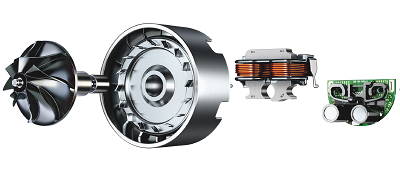The British appliance manufacturer Dyson claims to have developed the world’s fastest, most efficient motor for domestic appliances. The Dyson Digital Motor (DDM) v2 is a single-phase brushless DC motor, which operates at speeds up to 104,000 rpm with a claimed efficiency of 84%.
Dyson’s first digital motor, announced in 2003, used switched reluctance technology.

“Our new digital motor is small, fast, efficient and tough,” says the company’s chief executive, Sir James Dyson (shown above with the new motor, left, and and an older equivalent, right). “Its ability to control impeller speed and energy use puts it in a new class of clean motor.”
The 200W motor, developed over the course of about ten years by Dyson’s 45-strong team of motor developers, is protected by 15 patents. The company expects to use the motors in about 1.2 million appliances this year – initially in a pair of handheld, battery-operated vacuum cleaners.
The motor technology “opens up diverse engineering possibilities,” the company says, “powering smaller, lighter, greener appliances”.
Dyson says that the brushless motors are twice as efficient as the brushed motors that it used previously. This will give the portable vacuum cleaners a battery life of ten minutes with constant high levels of suction. A high-power mode gives six minutes of higher suction to deal with stubborn dirt or muddy footprints.

The 55.8mm-diameter motor (shown above in an exploded view with a vacuum cleaner impeller) is a third of the size of its predecessor. It weighs 139 grammes and has fewer components than earlier versions.
The new motor incorporates rare-earth (neodymium) permanent magnets and on-board digital circuitry to switch the polarity of the stator field. The self-regulating, microprocessor-controlled motor makes 3,300 adjustments every second to control its speed in response to changes in the vacuum airflow. Constant motor power maintains maximum performance, regardless of changes in the battery voltage or the operating speed.
Dyson argues that the brushless design will make the motors more reliable than brushed designs that suffer from mechanical wear, friction and the production of carbon particles that can affect airflows in a vacuum cleaner.
The first products to use the new DDM are two handheld vacuum cleaners – the DC 31 (which costs £130 in the UK) and the DC 31 Animal (£150), which incorporates a motorised brushbar to tackle stubborn pet hair. Dyson claims that these products overcome a common problem with handheld vacuum cleaners that rely on filters to capture dust particles and lose suction as they clog up. The DC 31 uses a patented technology to spin dust and dirt out of the air.
Dyson manufactures 100,000 vacuum cleaners every week, which are designed by a team of 300 engineers and scientists in the UK, and assembled in Malaysia. Since 1993, the company has sold more than 28.6 million vacuum cleaners – 40% of them since 2006. Last year, 80% of the company’s sales were outside the UK.




